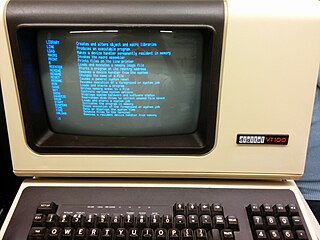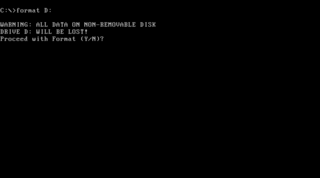uniq is a utility command on Unix, Plan 9, Inferno, and Unix-like operating systems which, when fed a text file or standard input, outputs the text with adjacent identical lines collapsed to one, unique line of text.

In computing, dir (directory) is a command in various computer operating systems used for computer file and directory listing. It is one of the basic commands to help navigate the file system. The command is usually implemented as an internal command in the command-line interpreter (shell). On some systems, a more graphical representation of the directory structure can be displayed using the tree command.
In computing, a command is a directive to a computer program to perform a specific task. It may be issued via a command-line interface, such as a shell, or as input to a network service as part of a network protocol, or as an event in a graphical user interface triggered by the user selecting an option in a menu.

head is a program on Unix and Unix-like operating systems used to display the beginning of a text file or piped data.

less is a terminal pager program on Unix, Windows, and Unix-like systems used to view the contents of a text file one screen at a time. It is similar to more, but has the extended capability of allowing both forward and backward navigation through the file. Unlike most Unix text editors/viewers, less does not need to read the entire file before starting, allowing for immediate viewing regardless of file size.
tail is a program available on Unix, Unix-like systems, FreeDOS and MSX-DOS used to display the tail end of a text file or piped data.
In computing, tee is a command in command-line interpreters (shells) using standard streams which reads standard input and writes it to both standard output and one or more files, effectively duplicating its input. It is primarily used in conjunction with pipes and filters. The command is named after the T-splitter used in plumbing.
In computing, sleep is a command in Unix, Unix-like and other operating systems that suspends program execution for a specified time.

In computing, tree is a recursive directory listing command or program that produces a depth-indented listing of files. Originating in PC- and MS-DOS, it is found in Digital Research FlexOS, IBM/Toshiba 4690 OS, PTS-DOS, FreeDOS, IBM OS/2, Microsoft Windows, and ReactOS. A version for Unix and Unix-like systems is also available.

In computing, type is a command in various command-line interpreters (shells) such as COMMAND.COM, cmd.exe, 4DOS/4NT and Windows PowerShell used to display the contents of specified files on the computer terminal. The analogous Unix command is cat.

In computing, the print command provides single-user print spooling capability in a number of operating systems. It is roughly similar to that provided by the UNIX System V lp and BSD lpr print spooler systems.

In computing, find is a command in the command-line interpreters (shells) of a number of operating systems. It is used to search for a specific text string in a file or files. The command sends the specified lines to the standard output device.
In computing, label is a command included with some operating systems. It is used to create, change, or delete a volume label on a logical drive, such as a hard disk partition or a floppy disk. Used without parameters, label changes the current volume label or deletes the existing label.

In computing, help is a command in various command line shells such as COMMAND.COM, cmd.exe, Bash, qshell, 4DOS/4NT, Windows PowerShell, Singularity shell, Python, MATLAB and GNU Octave. It provides online information about available commands and the shell environment.

In computing, copy is a command in various operating systems. The command copies computer files from one directory to another.

In computing, format, a command-line utility that carries out disk formatting. It is a component of various operating systems, including 86-DOS, MS-DOS, IBM PC DOS and OS/2, Microsoft Windows and ReactOS.

In computing, choice is a command that allows for batch files to prompt the user to select one item from a set of single-character choices. It is available in a number of operating system command-line shells.

A command-line interpreter or command-line processor uses a command-line interface (CLI) to receive commands from a user in the form of lines of text. This provides a means of setting parameters for the environment, invoking executables and providing information to them as to what actions they are to perform. In some cases the invocation is conditional based on conditions established by the user or previous executables. Such access was first provided by computer terminals starting in the mid-1960s. This provided an interactive environment not available with punched cards or other input methods.

In computing, replace is a command that is used to replace one or more existing computer files or add new files to a target directory. Files with a hidden or system attribute set cannot be replaced using replace. The command lists all files that are replaced.

cat is a standard Unix utility that reads files sequentially, writing them to standard output. The name is derived from its function to (con)catenate files. It has been ported to a number of operating systems.














